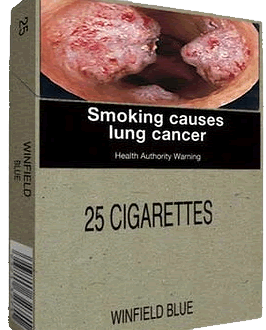At last, truth in cigarette advertising
In 2010 the Australian government announced that all cigarette packaging will have a generic look, as shown on the right. Branding of cigarettes will be illegal from January 2012.
The article below appeared in the Sydney Morning Herald.

BECKY FREEMAN AND SIMON CHAPMAN
April 29, 2010
From January 2012, all cigarettes will be sold in plain packages. No logos, no shiny finishes, no bright colours, no pretty pictures. Instead of reassuring and persuasive brand imagery, graphic health warnings will dominate the pack. The tobacco industry has long acknowledged the huge importance that packaging has within the marketing mix. In 1995, a tobacco industry executive summed it up perfectly, ". . . if you smoke, a cigarette pack is one of the few things you use regularly that makes a statement about you. A cigarette pack is the only thing you take out of your pocket 20 times a day and lay out for everyone to see. That's a lot different than buying your soap powder in generic packaging."
Plain packaging is nothing short of a triumph for health promotion and chronic disease prevention. In studies with young people, plain packs were perceived as dull and boring, cheap-looking and reduced the flair and appeal associated with smoking. Conversely, the industry has invested heavily in researching and designing packages that serve to increase the appeal of smoking. In the industry's own words, packs aimed at younger women should be "slick, sleek, flashy, glittery, shiny, silky, and bold". A brown box featuring a diseased lung can hardly be seen as fitting this glamorous description.
Investment firm Citigroup has already issued a response on Australia's move to implement plain packaging, viewing it as the "biggest regulatory threat to the industry, as packaging is the most important way tobacco companies have to communicate with the consumer and differentiate their products". This is a ringing endorsement that plain packaging is a public health winner.
The tobacco industry and their think-tank allies will argue that plain packaging is in violation of intellectual property rights and an unfair acquisition of valuable trademarks. While it is true that plain packaging legislation would regulate the use of tobacco trademarks, the federal government would not be acquiring the exclusive use of these trademarks or banning tobacco companies from using these trademarks in other communications.
Given the shaky ground the industry's legal arguments are based on, they will next claim that plain packaging will increase smuggling, cause an explosive rise in black market cigarettes and reduce the government's tax take from tobacco. While there is no evidence that Australia has a significant tobacco black market, a more rational response is to allocate resources to enforce existing anti-smuggling laws. In reality, plain packaging will only affect tobacco industry profitability.
No doubt hardened smokers will scoff at the notion that plain packaging could possibly influence their decision to either quit or to keep smoking. But this is certainly not the case for younger, new smokers. Just as designer clothing, fashion accessories and fast cars serve as cues to style, status and character so too can a cigarette pack reinforce social identity. Under these new packaging laws cigarette packs will only serve to signify addiction, disease, and death. Finally, there will be some truth in cigarette advertising.
Why is a cigarette packet such a high profile item, similar to a person's mobile phone?
According to industry experts, does branding make a difference to the type of cigarette one smokes? Explain.
Which group in our society is the ban on branding aimed at? Explain.
Offer a number of points whether generic branding will reduce the frequency of smoking in our society.
What is the industries objection to the generic ruling based on?
View the video on the right. TEN NEWS at 5. 2010.
According to the story, why are cigarette companies concerned?
Do they really care about the corner store owner?
One corner store owner claims that it takes longer to serve customers cigarettes. Is this a bad thing?
The cigarette companies say that new branding rules will not have an impact on sales. So why are they campaigning against such a law?
Why are cigarette companies concerned about the new packaging rules?
Should political parties accept funding from cigarette companies? Explain.
What is your position on this matter?
What are the argumanets of British Tobacco to plain packaging?
How does Prof Simon Chapman argue these these key points?